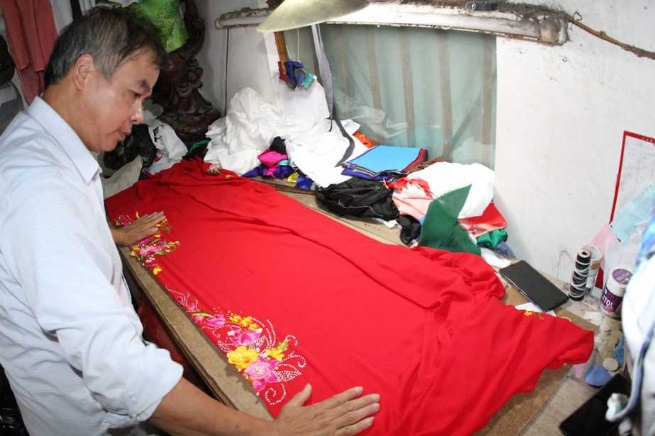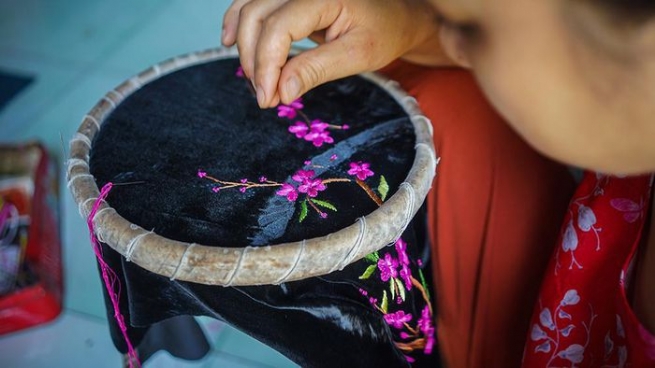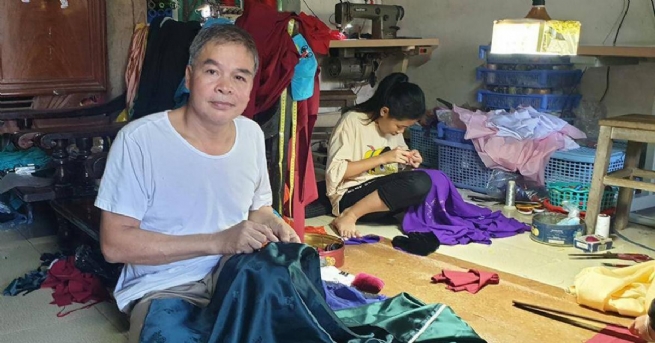9:18:44 AM | 9/8/2024
Upholding a proud tradition, artisans of Trach Xa village in Hoa Lam commune, Ung Hoa district, Hanoi, craft exquisite Ao Dai (traditional Vietnamese dress) with skill and dedication. Whether traveling or working in their village, they preserve the elegant artistry of this traditional Vietnamese dress. Their exceptional craft earned Trach Xa national recognition, being listed as a national intangible cultural heritage in February 2024.

The Trach Xa tailoring craft is recognized as part of the national intangible cultural heritage
Preserving the soul of the countryside in every dress
Situated approximately 45 kilometers from Hanoi's center, Trach Xa is renowned for its traditional dress tailoring, a craft that has been passed down through generations. The villagers have migrated to many regions, spreading their expertise and establishing prominent dress-making brands, including well-known tailoring shops on Luong Van Can street in Hanoi.
A distinctive aspect of Trach Xa craft village is the predominance of men in the tailoring profession, a tradition rooted in historical practices where women were only permitted to assist men. However, societal changes have since granted women equal opportunities in the craft. Today, Trach Xa village boasts around 300 households engaged in tailoring, providing employment for over 600 workers. The village’s average annual production value reaches approximately VND7 billion.
Artisan Nghiem Xuan Dat, Director of the Trach Xa Dress Tailoring Village Cooperative, noted that traditionally, craft secrets were passed down from elders to their sons rather than daughters. This practice came from the historical demands of the profession, which required frequent travel and bespoke tailoring at clients' homes. The craft requires diligence, precision, and meticulous attention to detail to ensure each garment is flawlessly constructed.
As a result, Trach Xa tailors have developed unique techniques that are not easily mastered. Today, many women in Trach Xa have been trained in the craft and have successfully advanced it, exemplified by establishments such as My Hanh tailor at Nga Tu So intersection and Thanh Chau tailor on Mai Hac De street. Meanwhile, boys in the village have traditionally been introduced to tailoring at a young age, around 6 or 7 years old, and receive extensive training throughout their formative years.

Le Van Thuy, a skillful artisan in Trach Xa’s dress-making tradition, emphasized that despite numerous changes over time, the village’s tailoring craft remains steadfastly traditional. Local artisans continue to adhere to the classic five-panel dress and have resisted blending their techniques with modern trends. A distinguishing feature of Trach Xa’s dress-making is its use of vertical hand-stitching, in contrast to the horizontal hand-stitching commonly employed elsewhere. This vertical technique offers a strong needle support point and ensures a rapid, even, and aesthetically pleasing stitching process.
"The vertical hand-stitching technique allows the worker to conceal the needle and thread lines beneath the stitching, unlike the horizontal technique, which often leaves thread lines visible on the inside of the garment. This method enables Trach Xa artisans to completely hide the needle and thread lines within the fabric," Mr. Le Van Thuy said.
The village is home to many skilled artisans recognized for their craftsmanship. Trach Xa’s garments have been showcased at numerous craft fairs in Hanoi. Today, Trach Xa is not just a traditional craft village but also a cultural destination, attracting both domestic and international tourists.

Preservation and development
Trach Xa village has undergone significant transformation, with new shops and tailoring establishments emerging along the village roads, modern homes being built, and residents enjoying improved livelihoods. Mr. Nghiem Van Mien, Head of Trach Xa village, noted that the dress tailoring profession is currently experiencing strong growth. Of the village's 520 households, 80% are involved in the craft, with 200 households operating large-scale shops and handling substantial orders.
What distinguishes the Trach Xa craft village is its commitment to traditional hand-sewing techniques, which include unique methods that set it apart. Each dress is tailored to individual measurements rather than being mass-produced. Additionally, young people in the village are embracing and expanding the craft, ensuring its continued development and vitality.

Artisan Do Minh Tam is sewing the ao dai very meticulously with every needle and thread
Despite facing many challenges, Trach Xa sewing village has successfully preserved its traditional craft across generations. Today, the village comprises about 540 households, with approximately 90% involved in tailoring.
Mrs. Nghiem Thi Mui, a resident who married into Trach Xa, shared that although her husband, originally from the village, was unable to pursue the profession due to illness, their three children have embraced the village's craft. "Since they were 10 years old, my children have learned the trade from skilled artisans in the village," she said.
What distinguishes Trach Xa as a unique brand is the meticulous craftsmanship that ensures the hem of each dress remains soft and flowing. This requires great precision in measuring and cutting. The tailor must carefully hold the needle vertically to avoid deviations, sew the hem evenly, and select fine, smooth, durable threads to achieve a high-quality finish.

Trach Xa village
Nguyen Van Chi, Director of the Hanoi Sub-department of Rural Development, noted that each craft village in the capital has its own distinct identity, producing unique and sophisticated items that reflect national cultural heritage. Trach Xa traditional craft village in Ung Hoa District, renowned for its dress-making, has the potential to develop into a creative design center model. This center would focus on introducing, promoting and selling OCOP products and craft village goods, while also integrating tourism. Such a model promises to provide a platform for designers and artisans to showcase their work, introduce traditional products, and create distinctive items like dresses and traditional costumes. Enhancing the integration of tourism and visitor experiences will be important for adding value to the craft village.
By Bao Ngoc, Vietnam Business Forum
The page in collaboration with Hanoi Rural Development Department